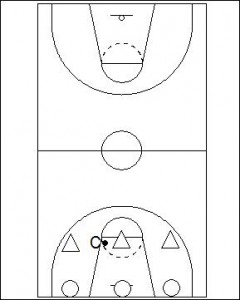3 v 3 Line Touch Transition Drill
The 3 v 3 Line Touch Transition Drill can be used for a range of different circumstances in your team’s tactical development. 3 v 3 drills often help teams build up to the full five main game principles without clogging areas on the court so the offense becomes stifled. The 3 v 3 line touch transition drill can also be great for developing your defence against a fast break basketball as well.
When looking to develop offensive principles in a breakdown situation the 3 v 3 line touch transition drill is fantastic for a number of reasons. One of the core reasons is it creates an advantage situation only as long as the third defender takes to recover and help. This means the offensive team must utilise its advantage in a very concerted effort to keep the offensive speed ahead of the defensive recovery. This situation creates a sense of urgency which in regular drills is hard to replicate. Watch your offensive players; they will play a little harder, to go that little faster because they want to keep the player advantage.
For offensive players the 3 v 3 line touch transition drill is the perfect drill to have 2 v 1 and 3 v 2 situations. In the early stages of this drills progress if the lane runners are quick enough they can isolate the defensive player who attempts to get back to the basket. This will allow these players to practice the 2 v 1 offensive principles of a fast break. If the fast break is slower, then the 3 v 2 offensive situations will unfold.
The really great aspect of the 3 v 3 line touch transition drill is that the 2 v 1 and 3 v 2 fast break situation will happen quickly, at pace and the reads will need to be made on the run. All the practicing and planting of the seed on what happens in these situations now comes to fruition. By placing your players in this situation you will be able to determine where further weaknesses exist and formulate strategies to deal with these.
For the defensive players the focus should be primarily to slow the pace of the ball and control the areas in which the ball can be advanced. Simultaneously the second defender in the initial two man defensive transition should be moving to protect the basket. The path for this defender should be down the middle lane of the court. The basket defender needs to only be two or three metres in front of the line of furthest offensive player. This allows this defender to fill space on the court and at least be in a position to take advantage of their defensive awareness should the opportunity arise for an interception or steal.
If the basket defender retreats to the basket too soon they will only encourage the ball to be passed to the wing and as a result a 2 v 1 situation will be created more easily by fast break offense. It should be noted the lower the number of players involved in the game scenario (for example 2 v 1 compared to a 3 v 2) the higher the percentage of successful scoring plays made. So therefore the first goal of the defence should be to slow progress of the ball leading to a 3 v 2 situation with the second objective being to slow the offense significantly enough that the fast break finishes as a 3 v 3 situation.

Coach passes the ball to any of the offensive players standing on the base line. The defender facing the offensive player who receives the ball must ouch the baseline before taking part in transition defence.
The other two defensive players must communicate and slow the pace of the ball long enough for their team-mate to recover.
Offensive players quickly advance the ball trying to create situations such as 3 v 2 or 2 v 1 by isolating the defenders.
When using any breakdown drill like the 3 v 3 line touch transition drill make sure the offense looks to create the 2 v 1 fast break situation first and foremost, with the second stage of the offense leading to 3 v 2. This will encourage your players to have an aggressive and proactive mindset which is demand in the higher levels of basketball competition.





